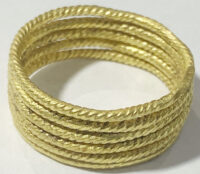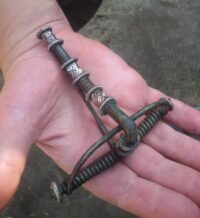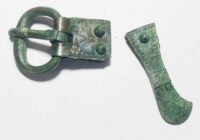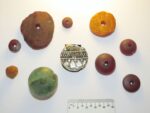 Archaeologists have unearthed richly furnished graves in a 3rd-7th century A.D. burial ground on the Sambian peninsula in Russia’s Kaliningrad oblast. They belonged to the elite of the late Roman, Migration Period and early Middle Ages, many of whom prospered thanks to the enduring trade in Baltic amber as well as other prized commodities like fur, homey and wax. The graves prove that a distinctive elite arose in the area in the 3rd century, two centuries earlier than previously believed.
Archaeologists have unearthed richly furnished graves in a 3rd-7th century A.D. burial ground on the Sambian peninsula in Russia’s Kaliningrad oblast. They belonged to the elite of the late Roman, Migration Period and early Middle Ages, many of whom prospered thanks to the enduring trade in Baltic amber as well as other prized commodities like fur, homey and wax. The graves prove that a distinctive elite arose in the area in the 3rd century, two centuries earlier than previously believed.
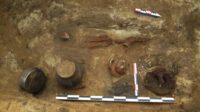 A team from the Institute of Archeology of the Russian Academy of Sciences began excavating the Putilovo-2 cemetery site three miles from the shores of the Baltic in 2015 for the first time in 150 years. In four years of exploration, they have revealed a two-acre burial ground. Excavations expanded this year in anticipation of new highway construction in the area.
A team from the Institute of Archeology of the Russian Academy of Sciences began excavating the Putilovo-2 cemetery site three miles from the shores of the Baltic in 2015 for the first time in 150 years. In four years of exploration, they have revealed a two-acre burial ground. Excavations expanded this year in anticipation of new highway construction in the area.
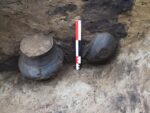 Most of them are cremation burials with cinerary remains interred in urns. They range from simple vessels buried in a small pit to large, elaborate urns buried in wooden boxes with extensive grave goods. The urns and coffins were covered with large slabs and then topped with stones. While the burials were extensively looted in the Middle Ages, both for their metal contents and for the slab stone reused by the Teutonic knights in castle construction. Ironically, slabs that collapsed into the graves ended up protecting the contents from looters as the broken slabs were no longer usable and thieves assumed there was nothing left under the busted roof.
Most of them are cremation burials with cinerary remains interred in urns. They range from simple vessels buried in a small pit to large, elaborate urns buried in wooden boxes with extensive grave goods. The urns and coffins were covered with large slabs and then topped with stones. While the burials were extensively looted in the Middle Ages, both for their metal contents and for the slab stone reused by the Teutonic knights in castle construction. Ironically, slabs that collapsed into the graves ended up protecting the contents from looters as the broken slabs were no longer usable and thieves assumed there was nothing left under the busted roof.
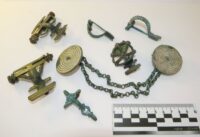 Grave goods that have been discovered thus far include pottery, jewelry of bronze, silver and gold, fibulae in a wide variety of shapes and sizes, torques, bangles, belt buckles, amber beads, weapons and tools. Roman silver and brass coins minted in the 1st and 2nd centuries were found in large numbers in the 4th-5th century graves. By this time they weren’t simple currency so much as objects of great symbolic value.
Grave goods that have been discovered thus far include pottery, jewelry of bronze, silver and gold, fibulae in a wide variety of shapes and sizes, torques, bangles, belt buckles, amber beads, weapons and tools. Roman silver and brass coins minted in the 1st and 2nd centuries were found in large numbers in the 4th-5th century graves. By this time they weren’t simple currency so much as objects of great symbolic value. 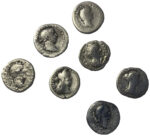 Archaeologists believe they may have been deemed to have currency value in the afterlife, which is why they were found in the graves of people of all ages and classes.
Archaeologists believe they may have been deemed to have currency value in the afterlife, which is why they were found in the graves of people of all ages and classes.
Four of the graves were marked as members of the local elite by their contents. One features a large urn buried with a jar, a spearhead, a bronze dagger, a fibula, scissors, a gold ring, an iron shield 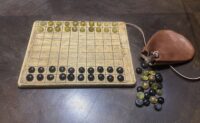 boss and a unique large set of glass game pieces for the board game Ludus latrunculorum. The game was popular throughout the Roman Empire and environs including modern-day Poland and Scandinavia. This set is extraordinary because there are almost 100 pieces that were preserved in a pouch. Nothing like it has been found in the Kaliningrad region for 170 years, and never before in the Sambian peninsula.
boss and a unique large set of glass game pieces for the board game Ludus latrunculorum. The game was popular throughout the Roman Empire and environs including modern-day Poland and Scandinavia. This set is extraordinary because there are almost 100 pieces that were preserved in a pouch. Nothing like it has been found in the Kaliningrad region for 170 years, and never before in the Sambian peninsula.
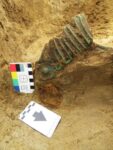 This man in this grave was so important that he was buried with not one, not two, but three horses. One of them still had its bronze bridle on its mandible and another was buried with his grooming kit bag. There were other horse burials in the cemetery, but this is the only triple header.
This man in this grave was so important that he was buried with not one, not two, but three horses. One of them still had its bronze bridle on its mandible and another was buried with his grooming kit bag. There were other horse burials in the cemetery, but this is the only triple header.
The excavation is scheduled to continue for another six months. The artifacts will be cleaned and conserved for eventual display in area museums.
